| Designation: | Wiesel 1 |
 |
|---|---|---|
| Manufacturer: | MAK SYSTEM GESELLSHAFT MBH | |
| Product type: | Armoured Vehicles | |
| Name: | Reconnaissance Vehicle |
In order to increase the reconnaissance capabilities of the airborne reconnaissance brigades, it was necessary to equip existing WIESEL i TOW vehicles with a powerful reconnaissance and communication system. The intention was to ensure an increase in day/night observation under armour, independent of the weather conditions, as well as an optimization of battlefield presentation and communication with the command post. In its weight class, the WIESEL i Reconnaissance Vehicle is the only one worldwide which meets all functional requirements including encoded data communication.
The Wiesel 1 air-transportable armoured weapon carrier was developed to meet the requirements of the German Army by Porsche, with production and marketing being carried out by MaK System Gesellschaft mbH of Kiel as general contractor.
Between 1989 and 1992, the German Army took delivery of a total of 345 Wiesel 1 vehicles armed with a Raytheon Systems Company TOW ATGW launcher or a Rheinmetall 20 mm cannon. In addition, another seven vehicles were delivered to the US armed forces and four of these are being used for robotic trials purposes.
A variety of different turrets and weapons systems can be installed on the Wiesel 1, which enables it to undertake a wide range of roles on the battlefield. In addition to being used by airborne units, the manufacturer has also suggested that it can be used by attack forces, scouts, military police and border guards as well as rapid reaction forces.
The Wiesel 1 has also been tested and demonstrated in a number of other countries including Greece, Indonesia, Malaysia, Norway, Singapore, Thailand, the United Arab Emirates, the United Kingdom and the USA.
Several Wiesel 1 armoured weapon carriers, in both 20 mm and TOW configuration, were deployed by Germany to Somalia as part of United Nations forces in 1993.
In addition to the Wiesel 1, MaK has more recently developed the multipurpose carrier Wiesel 2 which has an extended base and nearly twice as much internal volume. Due to this it offers a much wider range of roles and missions. Details of the Wiesel 2 are given in the Armoured personnel carriers (tracked) section.
The Wiesel production has now opened again for the German Army which has selected the Wiesel 2 as the platform for its new LeFlaSys Stinger air defence system for which STN Atlas Elektronik is prime contractor.
Although the Wiesel 1 was originally designed by Porsche, MaK System Gesellschaft is now the design authority and is currently studying a number of additional variants for possible use by the German Army.
Although the German Army took delivery of 345 Wiesel 1 armoured weapon carriers, in early 1997 it had a total of 343 vehicles on strength, 210 armed with the Raytheon Systems Company TOW anti-tank guided missile system and 133 armed with the Rheinmetall 20 mm cannon.
The hull is of all-welded steel construction providing the crew with protection from 7.62 mm small arms fire and shell splinters. The driver sits at the front of the vehicle on the right and has three periscopes for observation to the front and sides; the centre one can be replaced by a passive periscope for night driving.
The engine, which is a standard VW production model, is to the left of the driver with an access hatch in the glacis plate. The engine drives via a three-speed ZF automatic transmission and a Porsche two-speed reduction gear with integrated Cletrac steering gear. The complete power pack can be removed and replaced in 10 minutes. The steering gear is operated by the driver via a steering wheel and allows a variable turning radius from infinite to 2.3 m. Pivoting on one track is possible by engaging the parking brake on one side.
The engine exhaust system is located in the cooling air exhaust flow on the left side of the vehicle. The exhaust gases are passed to the rear and cooled in the process. The closed crew compartment is at the rear of the hull and entry is by climbing over the sides of the vehicle. The flexible self-sealing rubber fuel tank has an explosion-retarding polyurethane liner and is mounted externally on the rear of the hull.
Suspension either side consists of three dual roadwheels, drive sprocket at the front, idler at the rear and one track-return roller. A Belleville spring assembly automatically provides track tension when the vehicle is travelling. The track consists of an endless rubber band with wire reinforcements. More recently, the German company Diehl has developed a new track called the Type 622 for the MaK Wiesel 1 light armoured vehicle.
Following extensive trials the Type 622 track has been accepted for service with the German Army. The track is of the double-pin type and has a life of around 6,000 km.
According to MaK System Gesellschaft mbH the Wiesel 1 is air-transportable by the following aircraft:
Variants
The front-driven AWC Wiesel 1 was designed for a variety of missions and deployments. Based on the same chassis, the integration of various turrets and weapon systems enables the production of a complete family of vehicles according to the requirements of the users.
In addition, the development of the extended base vehicle of the Wiesel offers the possibility of a second family of the Wiesel vehicle. Following the same principle as the short versions, various turrets and weapons systems can be integrated in the extended base vehicle chassis which has an additional roadwheel and is approximately 60 cm longer than the short version.
- Short version variants
AWC Wiesel 1 with 20 mm cannon (MK 20 A1)
This was built to meet the requirements of the German Army and is fitted with a one-man KUKA turret E6-II-A1 armed with a 20 mm Rheinmetall MK 20 Rh 202 dual-feed cannon with 160 rounds of ready use ammunition, 60 rounds on the left side and 100 rounds on the right side, allowing the gunner to select the type of ammunition required to engage different targets. The weapon can be elevated from -10 to +45° and traversed 55° left and right. Elevation and traverse are manual and the gunner aims the weapon via a Zeiss PERI-Z-16 periscopic sight; a passive night sight is also available. This has two crew consisting of commander/ gunner and driver.
- AWC Wiesel 1 with TOW 2 (TOW A1)
This was built to meet the requirements ot the German Army and is fitted with a Raytheon Systems Company TOW ATGW launcher on an elevating pedestal with a traverse of 45° left and right and an elevation and depression of 10°. Seven missiles are carried of which two are for ready use. This model has a crew of three; driver, gunner and loader.
- AWC Wiesel 1 BTM 208, reconnaissance vehicle
This is fitted with the French SAMM BTM 208 turret armed with one 7.62 mm machine gun (with 200 rounds of ready use ammunition and 300 rounds in reserve) and one 12.7 mm M2 HB machine gun (with 100 rounds of ready use ammunition and 400 rounds in reserve). This remains at the prototype stage.
- AWC Wiesel 1 BTM 263, mortar system
This version has a SAMM BTM 263 turret and is armed with a 60 mm mortar and a 7.62 mm machine gun. In total 24 mortar bombs are stowed in the cupola and 200 rounds of 7.62 mm ammunition are carried. The weapons can be elevated from -7 to +70° with turret traverse a full 360°. This version has two crew. This remains at the prototype stage.
- AWC Wiesel 1 with 30 mm RMK 30 cannon
Early in 1997, Mauser-Werke Obemdorf Defense Systems released brief details of a new 30 mm cannon, designated the RMK 30, which it has developed under contract to the German BWB.
The RMK 30 is claimed to be a revolutionary new recoilless automatic cannon which has no recoil forces during single shots or burst rates of fire.
This feature enables the RMK 30 to be installed on helicopters and light armoured vehicles. The first production application tor this weapon is expected to be the German Army version of the Eurocopter Tiger helicopter which is still at the prototype stage.
At a later date the RMK 30 could also be fitted to the MaK Wiesel 1 light air-portable armoured vehicles, used by the German Army, which are at present armed with a Rheinmetall 20 mm MK 20 Rh 202 cannon.
Late in 1996, the RMK 30 automatic cannon was demonstrated to high-ranking German Army officers during a live firing exercise at the Heuberg/Baden-Wurttemberg troop testing grounds.
For this trial the weapon was installed on the MaK Wiesel 1 light air-portable armoured vehicle with the weapon being fired by remote control. Accurate rapid single shots and bursts of four and five rounds were fired on a target at a range of 1,500 m.
The new RMK 30 automatic cannon fires new 30 mm ammunition also developed by Mauser; this is of the telescoped type.
- AWC Wiesel 1 with HOT/ATM
In 1997, Euromissile, teamed with Thomson TTD Optronique, completed final development and integration of a new weapon system called HOT/ATM which on the same platform combines advanced observation and firing capabilities. In the designation HOT/ATM the latter stands for Anti-Tank Modular. For trials purposes, HOT/ATM has been installed on the Wiesel 1 chassis.
The HOT/ATM system has been developed to meet the-requirements of the French and German armies for a system capable of being installed on light tracked and wheeled armoured vehicles which can carry out advanced observation as well as engaging targets with HOT ATGM out to a maximum range of 4,000 m.
The turret is fitted with a mast-mounted stabilised sensor pod which features a TV camera, thermal camera (10 u.m), EBO (1 *,m electro-optical block) and a laser range-finder.
Roles of the sensor pod include observation, detection, localisation, display, automatic target tracking and missile tracking.
The monitoring and display module is fitted inside the vehicle and allows the operator to carry out battlefield surveillance, accurate target localisation on a digital terrain map, automatic target tracking, target selection prior to engagement and HOT missile launching with a very short reaction time.
The turret is unmanned with the operator being seated in the vehicle on the right with the vehicle commander to his left.
Mounted either side of the turret are one or two HOT ATGMs in the ready to launch position. Other weapon combinations are possible such as 7.62 or 12.7 mm machine gun or the new Mauser RMK 30 recoilless 30 mm cannon which has already been tested during recent unmanned firings. Other ATGM can also be fitted such as the EMDG TRIGAT Medium Range.
In addition, the HOT/UTM can exchange surveillance and firing data with neighbouring systems as well as upper level C3I systems.
In addition to the Wiesel 1, the HOT/ATM system can be fitted on to a wide range of tracked and wheeled vehicles such as the French Panhard VBL (4 x 4), Giat Industries VAB (4x4 or 6x6), Steyr-Daimler-Puch Pandur (6x6), Patria Vehicles Oy (formerly SISU) XA-185 series (6 x 6), Russian BMP-1/2, and the US AM General HMMMVW (4 x 4).
- AWC Wiesel 2 Stinger, anti-aircraft system
The German Army has a requirement for an air-portable self-propelled air defence system called the Leichtes Flugabwehrsystem (LeFlaSys).
In early 1995, the German MoD selected the STN Atlas Elektronik Atlas Short-Range Air Defence (ASRAD) System to meet the LeFlaSys requirement.
This version is also based on the stretched Wiesel 2 chassis covered in detail in the Armoured personnel carriers (tracked) section.
- SYRANO robotic vehicle
This French robotic vehicle, covered in the Experimental and trials armoured fighting vehicles section, uses the chassis of the Wiesel 2.
- Other variants
Additional variants based on the short version of the Wiesel 1 include the AWC Wiesel 1 MILAN anti-tank system, the AWC Wiesel 1 RATAC-S for surveillance and target acquisition.
MaK has also completed the prototype of an experimental Wiesel 1 with an electric drive system and this has already completed its company tests.
- Wiesel extended base vehicle
The prototype of this version was completed by MaK early in 1994, details are given in the Armoured personnel carriers (tracked) section. It is now known as the Wiesel 2.
Production of the Wiesel 1 for the German Army was completed in 1992 but further production will now start as the Wiesel 2 chassis has been selected for the STN ATLAS Elektronik ATLAS Short-Range Air Defence (ASRAD) System.
• Observation system AOZ 2000
• Command and control system FaKom
• Hybrid navigation system with GPS
Test vehicle for troop testing was delivered in 2002.
|
||||||||||||||||||
|
|||||||||||||||
|
|||||||||||||||
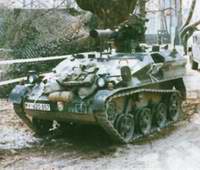 |
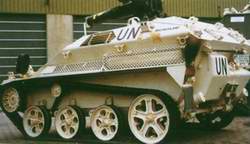 |
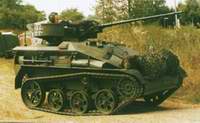 |
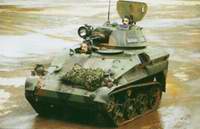 |
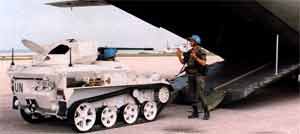 |
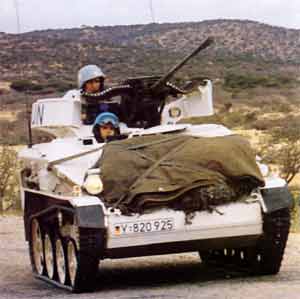 |
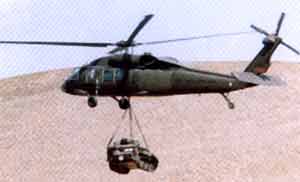 |
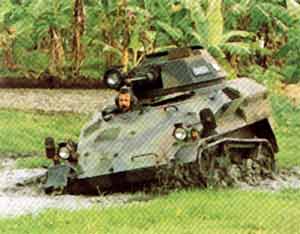 |
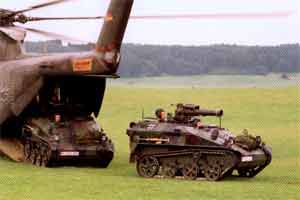 |
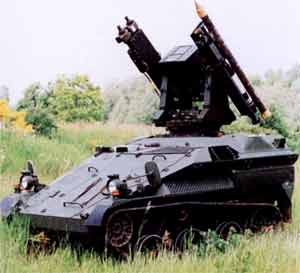 |
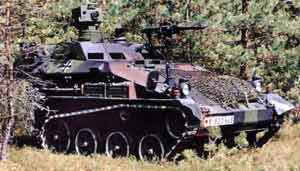 |


